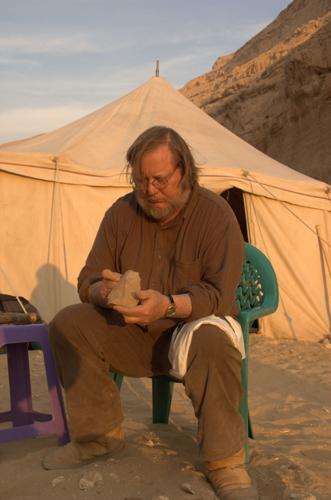Groundbreaking archaeologist Harold L. Dibble was renowned in the world of archaeology for not only revolutionizing excavation techniques but also for the 2010 discovery in Morocco of the oldest remains of a child, dating to 108,000 years ago.
He also made an impact locally while earning his degrees at the University of Arizona.
Dibble died of neuroendocrine cancer June 10 at the age of 66 at the Hospital of the University of Pennsylvania.
Dibble led 11 digs across France, Egypt and Morocco, focusing mostly on Neanderthals of the Middle Paleolithic era, 120,000 to 40,000 years ago.
Near the end of his time at the UA, Dibble recognized that many prehistoric artifacts would be best analyzed by techniques that were not yet invented.
A forward thinker, Dibble began creating computerized databases of archaeological digs for future scientists to analyze.
“That system he developed became a standard technique that has become indispensable,” said Arthur Jelinek, Dibble’s graduate professor at the UA’s School of Anthropology in the early 1970s.
Dibble’s sister Christine Burke, owner of Clues Unlimited in Tucson, said Dibble’s fascination with archaeology began at age 6 or 7 when they got their hands on a copy of “The March of Archeology” by C.W. Ceram from their dad’s collection.
Their father was a rocket scientist and one of the founders of what is now the Florida Institute of Technology. The Dibble family moved to Sierra Vista in 1964, when Harold Jr. was 13.
“It was pretty much a cowtown at that time,” Burke said. “Tucson was the big city compared to Sierra Vista.”
Dibble graduated from Buena High School and went on to get his bachelor’s and graduate degrees at the University of Arizona School of Anthropology.
Jelinek said Dibble was a very rare student to come across because of his enthusiasm and his ability to inspire passion in others.
“I remember him coming into my office and asking if he could volunteer to work in my laboratory,” Jelinek said.
“He would engage other students to help him with his projects.”
Dibble and his classmates would create stone tools to search for regularities among real artifacts and their re-creations.
Dibble went on to become a professor at the University of Pennsylvania where he led a laboratory centered around a robot named Super Igor that uses hydraulic power to re-create stone tools.
This research helped with another one of Dibble’s major contributions, a new theory on the Bordes-Binford debate.
The debate is whether differences in stone tools are representative of cultural differences in groups of people or functional differences, like the tools in a toolbox.
Dibble suggested that rather than think of the tools as a snapshot in time, you need to think about them as a movie. Just as an old pencil might be shorter than a new one, due to the amount of use, so could the stone tools appear different based on the amount of use they endured.
Dibble’s son, Flint, who is also an archaeologist, studying classical archaeology and zooarchaeology in Greece, went on his first dig with his father at just 16 years old.
“He really trained the next generation of archaeologists,” said Flint Dibble, Harold’s son who is a classical and zooarchaeologist studying ancient animals in Greece. “He would say, ‘Challenge yourself at all times; ask yourself: Am I assuming anything?’ ”
For the last few years of his life, Dibble worked at Pech de l’Azé IV in France, trying to uncover the Neanderthals’ use of fire.
“He really cared about evidence-based science,” said Beebe Bahrami, a journalist and anthropologist who covered Dibble’s digs in southwest France from 2010 to 2015.
“He expected a lot from people working on his dig sites, but he also recruited people with ambition,” said Bahrami, who was a freshman in Dibble’s archaeology class at the University of Pennsylvania. “He went out of his way to make sure people were comfortable and that they were having a good time.”
“He was the funniest person you’d ever meet,” said Burke, recalling her brother’s account of a lecture he gave in French where he made the mistake of using an American idiom, “more than one way to skin a cat,” to the horror of the European audience.
Burke added that Dibble had a love for music — he played drums and guitar — and a love for cooking.
“He would take a scientific approach to fun,” Flint said. “He would say that knowing the price of a wine or whiskey would affect your opinion of them, so we would do blind taste tests and things like that.”
He is survived by his wife, Lee, sons Flint and Chip — whose names were inspired by archaeological finds — and his sister, Christine Burke.








